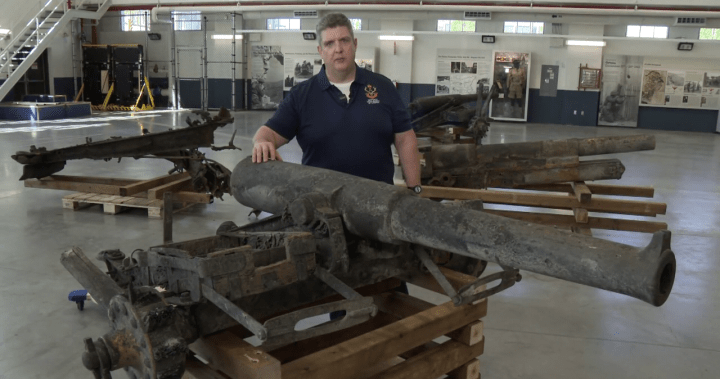A month after work crews dug up a piece of Canadian military history at the PNE in Vancouver, officials say they’ve found more — and believe the area could yet prove to be a goldmine for historians.
On March 27, crews building the new Freedom Mobile Arch amphitheatre discovered what appeared to be a “cannon.”
It turned out to be a captured German Howitzer from the First World War, taken as a trophy by Canadian soldiers.

Canadian troops actually brought a number of such weapons home, which were staged around the city for display in the years after the war, according to James Calhoun, curator for the Seaforth Highlanders of Canada Museum.
The guns were moved to Hastings Park in the 1930s with plans to make a permanent display, but the Great Depression scuttled that plan.
By the 1940s, they were viewed as “junk,” he said, and it’s believed they were ultimately used to fill in a ravine on the site when the military took over the park in 1942.

Get breaking National news
For news impacting Canada and around the world, sign up for breaking news alerts delivered directly to you when they happen.
“It’s incredibly exciting. There have been rumours for years that they were going to find captured German guns buried at the PNE, and the first find on March 27 substantiated that — this subsequent find just shows that there was more stuff stored at the park.
“Two weeks later, we found a few more. We found two Canadian/British nine-pounder muzzle-loading artillery pieces from the 1870s … and we found a bunch of (German World War I) machine guns that came back as war trophies as well.”

Geordie Howe, an archaeologist with the Vancouver Park Board, said crews finishing the sewer installation for the amphitheatre made the latest find when they uncovered the rim of one of the cannon’s wheels.
A park board team used a hydrovac to expose the cannon and a loader to lift it out — only to discover a second cannon buried beneath.
“It’s actually pretty incredible that this material has been in the ground for over 80 years,” he said.
“All in the same general area.”
The latest finds were uncovered in the area southwest of the amphitheatre site, and will not affect the development of the new facility.
Calhoun, who has been researching the fate of the captured guns for years, says he believes there may be many more to uncover.

He’s particularly hopeful the “holy grail” find may be at the site — a 16,000-pound 210mm German Mörser captured by the Seaforth Highlanders outside the French town of Valenciennes and which once stood guard at the entrance to Stanley Park.
“We know there were between 15 and 16 artillery pieces stored at Hastings Park in 1933-34,” he said.
“We have found one, and we know five were cut up for scrap during the Second World War, but there could be as many as nine more artillery pieces south of the new amphitheatre they are building, and we think there might be at least 10 machine guns.”
Calhoun said he’s hopeful they will be able to keep digging at the site.
The items that have already been excavated will be restored and displayed at the Seaforth Museum.
Calhoun wouldn’t speculate on what the new discovery is worth financially, but he knows what it’s worth to Canada.
“In terms of historical value? Priceless.”
© 2025 Global News, a division of Corus Entertainment Inc.
‘Priceless’: More cannons, century-old machine guns discovered at PNE in Vancouver





